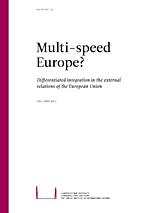Differentiated integration is not a new phenomenon in European integration. It has taken various forms over a wide range of policy areas in the past. Importantly, differentiated integration is not merely an internal question for the EU as the Union’s organization and internal dynamics also shape its external actorness. Consequently, various forms of differentiation are present in the EU’s external relations and policies.
The objective of this report is to take a closer look at differentiated integration in the EU’s external relations and, in so doing, to discuss its implications for the EU’s aspirations to forge more unitary and effective external policies. To this end, the contributors to this report will examine the different features of differentiated integration that currently exist in various fields of the EU’s external relations. Relatedly, they will analyze whether the level of differentiation is increasing and, if so, what the key drivers of the current trends are.
Thus far there is rather limited evidence that the level of differentiation is increasing in the EU’s external relations due to the ongoing developments related to the EU’s financial and economic crisis. Depending on the level and duration of differentiation embedded in the current reforms of the EMU, some consequences might occur in due course.

